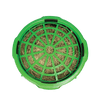The benefits to horses of steaming hay instead of soaking are now well known, the benefits to the environment are worth considering too.
With thousands of tubs of waste water being thrown away every day, horse owners are unwittingly polluting our water sources. It can take up to 50 litres of water to fill a container suitable for soaking hay, so the sheer volume of water used is a huge issue especially in areas of the world where water is scarce.
Beyond the volume of water used, the waste water from soaked hay, particularly if it has been soaked for several hours has a very high biological oxygen demand (BOD) and so is classed as an environmental pollutant.
BOD is a measure (in mg/litre) of the amount of oxygen required by micro-organisms to oxidise the organic content of a liquid. It determines how polluted a water supply is as the presence of organic matter in water results in millions of bacteria effectively feeding on it and in the process consuming much of the available dissolved oxygen in the water. This uses the oxygen aquatic organisms need to live.
This information was first revealed in 1992 when Warr and Petch from Writtle college published a paper in Equine Veterinary Education looking titled “Effects of soaking hay on its nutritional value.”
A series of laboratory analyses were performed on hay before and after soaking for times ranging from 5 minutes to 12 hours and on the resultant waste water samples produced. The BOD values of soak waste water were determined to confirm nutrient loss and to estimate potential pollution hazard.
The results found the longer hay is soaked, the more of an environmental pollutant the waste water becomes, in fact it can be far more polluting that raw sewage….ewww! If you take a hard look at the brown, frothy, smelly waste water and think about it this is less surprising than you might first think!
Research undertaken by Myerscough College further investigated the pollution (BOD) caused by disposal of water following soaking hay and a comparison with the waste water from a hay steamer (Blundell et al 2012).
The research confirmed Warr and Petch’s findings that waste water from soaking hay is highly polluted, with an excessively high BOD. It was at least 6 times greater than that found in the waste water from steaming hay which is mainly condensation from the steam. The research found that the BOD of waste water from soaking hay was as high as 7.97 mg/litre, a level considered to be highly polluted and similar to levels in rivers upstream of a sewage outflow.
What about the hay that comes out of this tub of filthy water?
Just a 10 minute soak can increase the bacterial count of the hay by 150% (Moore-Colyer et al 2012) In addition, Wyss and Pradervand found that microbial and bacterial contents increased sharply with increasing duration of soaking.
So, while soaking is effective at reducing airborne dust it severely compromises the hygienic quality of the hay. 
Steaming hay with a specially developed hay steamer not only makes your horse’s hay safer and healthier to eat it also helps protect the environment by dramatically reducing the pollution content of waste water from hay preparation.
Haygain steamed hay - an alternative to soaking which is healthier for your horse, easier for you and does your little bit for the environment.
References:
Blundell E.L., Adjei L.J., Brigden C.V. (2012) The effect of steaming and soaking treatments on respirable dust content of hay and the potential environmental polluting impact of the waste water produced. In: Saastamoinen M., Fradinho M.J., Santos A.S., Miraglia N. (eds) Forages and grazing in horse nutrition. Forages and grazing in horse nutrition, vol 132. Wageningen Academic Publishers, Wageningen
Moore-Colyer, M.J.S and Fillery, B.G. (2012) The Effect of three different treatments on the respirable particle content, total viable count and mould concentrations in hay for horses. 6 th European Workshop for Equine Nutrition, Lisbon, Portugal, June. 101- 106.
Warr EM, Petch JL (1992) Effects of soaking hay on its nutritional quality. Eq.Vet.Edu. 5:169–171.
Wyss, U. and Pradervand, N. (2016) Steaming or Soaking. Agroscope Science. Nr 32 p32-33



















